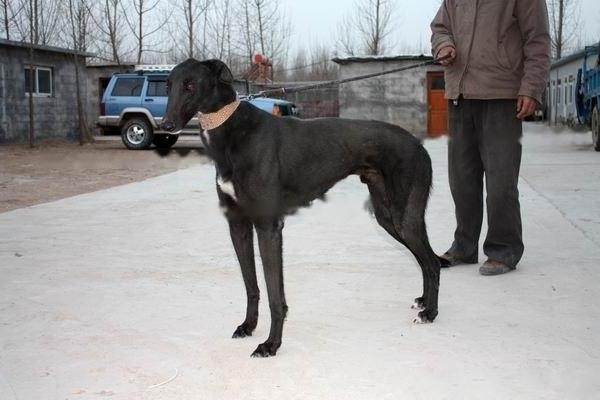The Greyhound, also known as the grey, is native to the Middle East and is the fastest running dog in the world. Adult dogs are 68-76 cm tall and weigh 27--32 kg. Greyhounds are extremely rare purebred dogs. In the modern world, the Australian Greyhound is recognized as the best, and all racing dogs are selected from Australia. The Greyhound does not have the habit of guarding the house, and does not like to bark and attack strangers; it is afraid of the cold, and most of the time lies languidly in a warm and comfortable place. However, once he finds prey or something to let him play with, he can display surprising speed and agility.

Gree dogs are not picky about food, but their nutrition should be comprehensive, especially protein and vitamins. Gree dog feed can be divided into three categories: animal feed, plant feed and additives. The newly born puppy is very weak, and the breeder should observe it at any time to prevent the bitch from crushing the puppy. The puppy can suck on its own after birth, but the weak puppy needs to be placed on the breast of the bitch to help it suck. A bitch has 8-10 nipples, and the feeding ability is limited. A large bitch can feed 10 puppies. If the number is too large, fostering or artificial feeding should be considered to ensure the healthy growth of the puppies.
Puppies generally refer to Gree dogs that are 60 days old to 3 months old. During this stage, due to weaning and changes in the living environment, puppies are often prone to mental and action uneasiness and loss of appetite. Careful care is required at this time. Feeding three times a day, calcium powder and vitamins should be added to the food, and special attention should be paid to prevent a small number of puppies from overeating and overeating. The daily feeding amount should depend on the size of the dog. It is good to be full, and feed each puppy about 150 ml of drinking water. Arrange an appropriate amount of outdoor exercise every day, and ultraviolet radiation is conducive to the absorption of calcium and the growth and development of bones.
Young dogs generally refer to Gree dogs that are 3 months to 6 months old after birth. The young dog has been able to live independently, and the feeding can be changed to twice a day. The feeding should be done regularly, quantitatively, qualitatively, and at a constant temperature. At this time, the canine teeth of the young dog have grown, and they like to bite. You can throw some bones to make them chew. The dog group should be separated according to the strength and weakness, pick out the young dogs who love fighting, and put them in the older dog group to avoid biting the group and causing losses.
Breeding dogs have high nutritional requirements, and generally in addition to feeding in the morning and evening, they should be fed once in the middle. To ensure the daily activity of the breeder, it should be active in the large activity field 2 to 3 times a day for about 30 minutes each time. This can not only ensure the quality of the male dog, but also enhance the physique of the female dog. In order to avoid the occurrence of various canine diseases, Gree dogs should undergo programmed epidemic prevention during their growth. First of all, the Gree dog must be vaccinated. The first vaccination is 30 days old, the second vaccination is 60 days old, the third vaccination is 120 days old, and the immunization is given again at 6 months of age. The inoculation doses are subject to the drug instructions. Secondly, pay attention to checking the feces, and regularly give the Gree dog deworming drugs, such as Qu Ling or levamisole, etc., to drive out internal parasites. 60 days after the birth of the puppies, all the puppies should take Quzhuling once, and then every 2-3 months, but in areas with high parasite incidence, it should be once a month or once a month and a half.
The unique physiology and anatomy of the 5 Greyhound makes treatment often necessitated by a veterinarian familiar with the breed, especially if anesthesia is required. Greyhounds have distinctive blood properties that can lead to misdiagnosis by veterinarians unfamiliar with the breed. Greyhounds have much less fat than other breeds of dogs, so the rate of metabolism of anesthesia is slower. Plus, Greyhounds have a higher red blood cell content than other breeds because red blood cells are responsible for transporting oxygen to the muscles, which helps them gain speed. Veterinary blood services often use Gree blood because many of them are universal blood donors.
In order to avoid the occurrence of various canine diseases, programmatic vaccination should be carried out during the growth of Gree dogs. First of all, the Gree dog must be vaccinated. The first vaccination is 30 days old, the second vaccination is 60 days old, the third vaccination is 120 days old, and the immunization is given again at 6 months of age. The inoculation doses are subject to the drug instructions. Secondly, pay attention to checking the feces, and regularly give the Gree dog deworming drugs, such as Qu Ling or levamisole, etc., to drive out internal parasites. 60 days after the birth of the puppies, all the puppies should take Quzhuling once, and then every 2-3 months, but in areas with high parasite incidence, it should be once a month or once a month and a half.
![[Dog Training 5] The training method of pet dog dining etiquette](/static/img/12192/12192_1.jpg)




